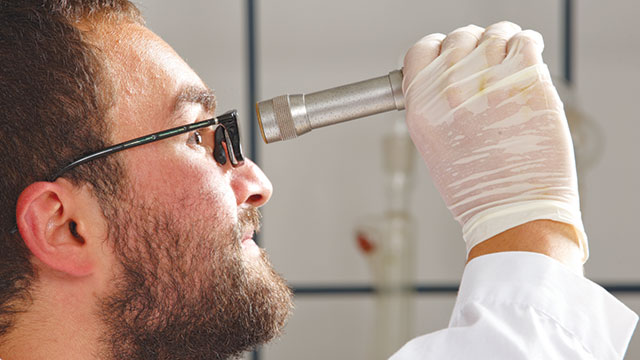
A great sculptor is alleged to have said that carving a great statue is easy; start with high-quality stone or metal, and remove everything that does not look like your subject. Similarly, Kevin Chapman, product manager at Bellingham + Stanley, a Xylem brand (Kent, UK), notes that many factors can negatively affect accuracy in refractometry. “The secret is to eliminate them,” he quips.
Principal concerns are the instrument, the sample, the environment, and the people involved.
“Make sure you use the right instrument for the right job. A refractometer must be sensitive to the required accuracy, with features that eliminate potential confounding issues,” says Chapman.
A $100 handheld refractometer should not be used for pharmaceutical QC, but such an instrument might work for educational settings or rapid raw materials testing. Field measurements, including determination of fruit ripeness, represent another “quick and dirty” application for inexpensive refractometers. But technicians need to assure their samples are representative and, as Chapman cautions, not “from only the sunny side of the hill.” Samples vary greatly in terms of chemical makeup, previous processing or storage, and homogeneity. Interfering species like suspended solids can hinder measurements, so physical removal or negation through operating software should be applied where appropriate.
Related Article: Refractometers: Versatile Analyzers, from QC to LC
Technicians should use high-purity water for both cleaning and zero calibration. Take care with using squeeze bottles for cleaning and zeroing. Chapman explains, “Using the same bottle for regular prism cleaning and then for calibration presents the risk that contamination may transfer to water [that is] used to zero the refractometer. Not so bad if you withdraw the nozzle from the refractometer before drawing fluid in, but if you don’t, there’s a good chance of sucking contaminated water back into the bottle.”
While not terribly sophisticated in operation, refractometers nevertheless demand some level of training as a prerequisite for accurate measurement. Familiarity with company SOPs is a must, as is workflow-appropriate knowledge of sample preparation.
Temperature control and contamination
Of all the potential sources of error in refractive index (RI) measurements, the lack of temperature control is by far the most critical. Larry Martin, marketing manager at Rudolph Research Analytical (Hackettstown, NJ), notes that temperature correction works for only some samples. “You can use correction for sugar/water solutions to arrive at the correct Brix, but antifreeze or oils measurement precision demands temperature control within narrow limits,” he explains. Lack of temperature control is a main reason for replacing or upgrading refractometers, according to Martin.
Top refractometer companies such as Thermo Fisher, Reichert, Rudolph Research, and Bellingham include this critical feature. Rudolph refractometers, for example, incorporate Peltier heating and cooling temperature control systems above and below the sample, which creates a stable microenvironment for samples.
Another significant source of error is cross-contamination, which is when improperly cleaned prisms retain residual sample from the previous measurement. This source of error is so common that Rudolph developed a system called SmartMeasure™ to monitor and give the operator feedback on the cleanliness of the prism between measurements, along with sample load quality.
Most refractometers are calibrated to a zero reference point. Bellingham + Stanley’s Chapman suggests top-end calibration as well to maintain accuracy throughout the measurement range. For laboratories in the U.S., a standard traceable to the National Institute of Standards and Technology (NIST) is normally required for regulated work and is recommended for highprecision measurements. Commercial NIST-traceable standards are available from vendors, including Bellingham + Stanley.
“A non-calibrated or infrequently serviced refractometer isn’t much better than a random number generator,” Chapman says.
Show me the money
An RI will not always provide absolute concentrations, but it will determine whether today’s sample is the same as yesterday’s. “That allows you to say yes or no when a product reaches your receiving dock,” says Martin. When a drug is returned to a hospital pharmacy, for example, RI helps determine whether the medicine has been cut with water or otherwise adulterated. “If you’re running a chemical lab or a flavor and fragrance lab and buying raw materials, a refractometer will tell you whether that ethylene glycol or orange oil is at the right concentration or within product tolerances.”
With real money—and product quality—on the line, taking steps to assure the most accurate measurement possible is good science and good business.









